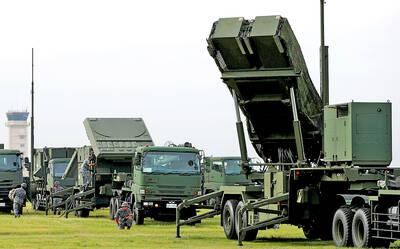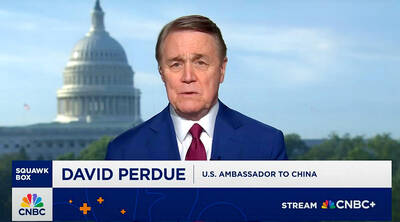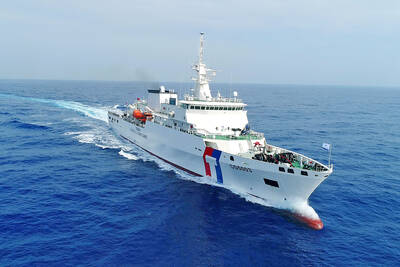US Federal Reserve Chairman Ben Bernanke and his colleagues may indicate the US recovery is gaining strength while repeating a pledge to keep the benchmark interest rate almost at zero for an “extended period.”
The Federal Open Market Committee (FOMC) gathers as growth in the final quarter of the year accelerates to more than 4 percent, the fastest pace in almost four years, according to analysts’ forecasts.
The FOMC will probably discuss how to eventually withdraw unprecedented programs to revive credit, including purchases of US$1.43 trillion in housing debt, economists said.
In a statement yesterday, Fed officials were expected possibly to head off investor expectations that the improving economy would prompt them to raise interest rates early next year.
While acknowledging that job losses are easing after last month’s drop in the unemployment rate, the FOMC could reaffirm that tight credit and weak income growth are among the risks to the recovery.
CONFIDENCE
“The last thing they want is for people to expect that tightening is closer,” said Laurence Meyer, vice chairman of Macroeconomic Advisers LLC in Washington and a former Fed governor. “They are going to increase their confidence about the sustainability of the expansion, but not become materially more optimistic about growth next year.”
The FOMC was scheduled to issue the statement at around 2:15pm after the end of its two-day meeting.
“Assuming they don’t drop ‘extended period,’ market reaction will probably be limited,” said James O’Sullivan, chief economist at MF Global Ltd in New York.
Macroeconomic Advisers raised its forecast for fourth-quarter growth last week to a 4.2 percent annual pace from 3.1 percent, while Credit Suisse and JPMorgan Chase & Co increased its estimate by 1 percentage point to 4.5 percent.
Retail sales last month climbed twice as much as economists had expected, while exports rose to the highest level in 11 months, government figures showed.
‘TWO BATTLES’
“The Fed has to fight two battles: supporting economic growth and showing the market it is concerned about potential inflation later on,” said Sung Won Sohn, former chief economist at Wells Fargo & Co and now a professor at California State University-Channel Islands in Camarillo, California. “Balancing inflation and economic growth and the communications related to that will be their most difficult challenge.”
Fed funds futures on the Chicago Board of Trade indicated on Tuesday a 53 percent chance that the FOMC will raise its main lending rate by at least a quarter-percentage point by its June meeting, compared with 35 percent odds a month ago.

MILITARY BOOST: The procurement was planned after Washington recommended that Taiwan increase its stock of air defense missiles, a defense official said yesterday Taiwan is planning to order an additional four PAC-3 MSE systems and up to 500 missiles in response to an increasing number of missile sites on China’s east coast, a defense official said yesterday. The official, who spoke on condition of anonymity, said that the proposed order would be placed using the defense procurement special budget, adding that about NT$1 trillion (US$32,88 billion) has been allocated for the budget. The proposed acquisition would include launchers, missiles, and a lower tier air and missile defense radar system, they said The procurement was planned after the US military recommended that Taiwan increase

POLITICAL AGENDA: Beijing’s cross-strait Mid-Autumn Festival events are part of a ‘cultural united front’ aimed at promoting unification with Taiwan, academics said Local authorities in China have been inviting Taiwanese to participate in cross-strait Mid-Autumn Festival celebrations centered around ideals of “family and nation,” a move Taiwanese academics said politicizes the holiday to promote the idea of “one family” across the Taiwan Strait. Sources said that China’s Fujian Provincial Government is organizing about 20 cross-strait-themed events in cities including Quanzhou, Nanping, Sanming and Zhangzhou. In Zhangzhou, a festival scheduled for Wednesday is to showcase Minnan-language songs and budaixi (布袋戲) glove puppetry to highlight cultural similarities between Taiwan and the region. Elsewhere, Jiangsu Province is hosting more than 10 similar celebrations in Taizhou, Changzhou, Suzhou,

TWO HEAVYWEIGHTS: Trump and Xi respect each other, are in a unique position to do something great, and they want to do that together, the US envoy to China said The administration of US President Donald Trump has told Chinese President Xi Jinping (習近平) “we don’t want any coercion, but we want [the Taiwan dispute] resolved peacefully,” US ambassador to China David Perdue said in a TV interview on Thursday. Trump “has said very clearly, we are not changing the ‘one China’ policy, we are going to adhere to the Taiwan Relations Act, the three communiques and the ‘six assurances’ that were done under [former US president Ronald] Reagan,” Perdue told Joe Kernen, cohost of CNBC’s Squawk Box. The act, the Three Joint Communiques and the “six assurances” are guidelines for Washington

DEEPENING TIES: The two are boosting cooperation in response to China’s coercive actions and have signed MOUs on search-and-rescue and anti-smuggling efforts Taiwan and Japan are moving to normalize joint coast guard training and considering the inclusion of other allies, the Japanese Yomiuri Shimbun reported yesterday. Both nations’ coast guards in June sent vessels to the seas south of the Sakishima Islands to conduct joint training, the report said, adding that it was the second joint maritime training exercise since the nations severed formal diplomatic ties in September 1972. Japan dispatched the Nagoya Coast Guard’s Mizuho, a 134m, 6,000-tonne patrol vessel which can carry a helicopter, while the Coast Guard Administration (CGA) sent the 126m, 4,000-tonne Yunlin, one of its largest vessels, the report